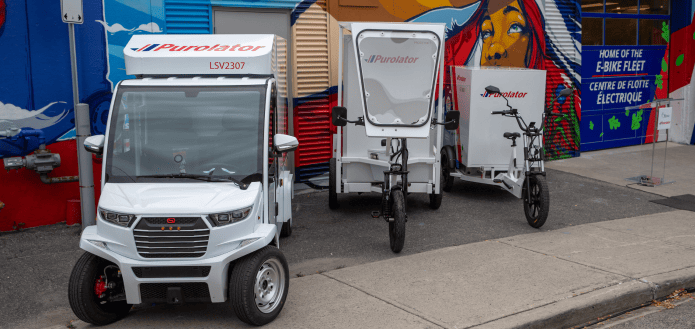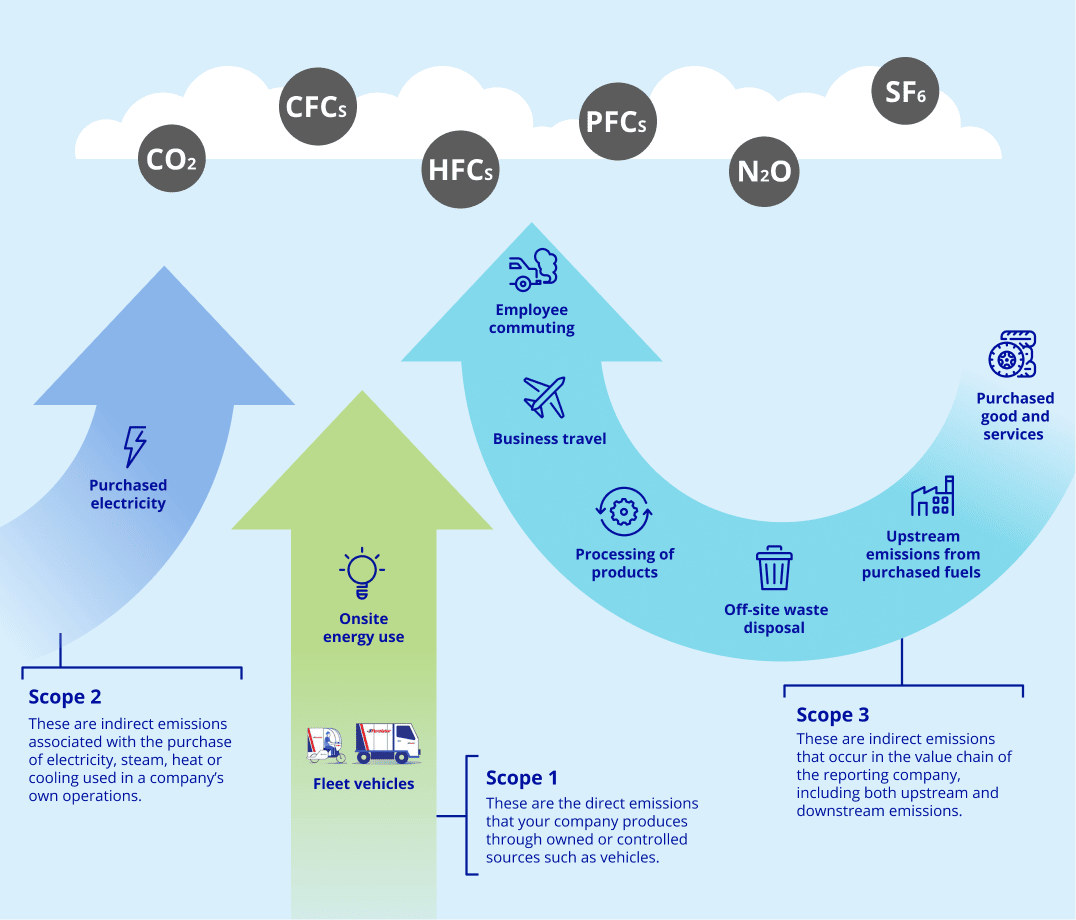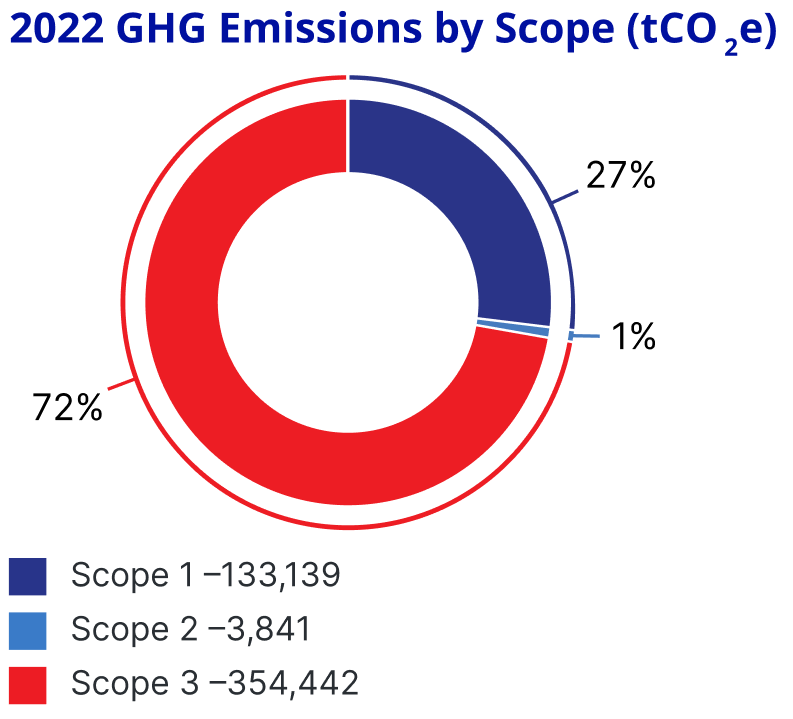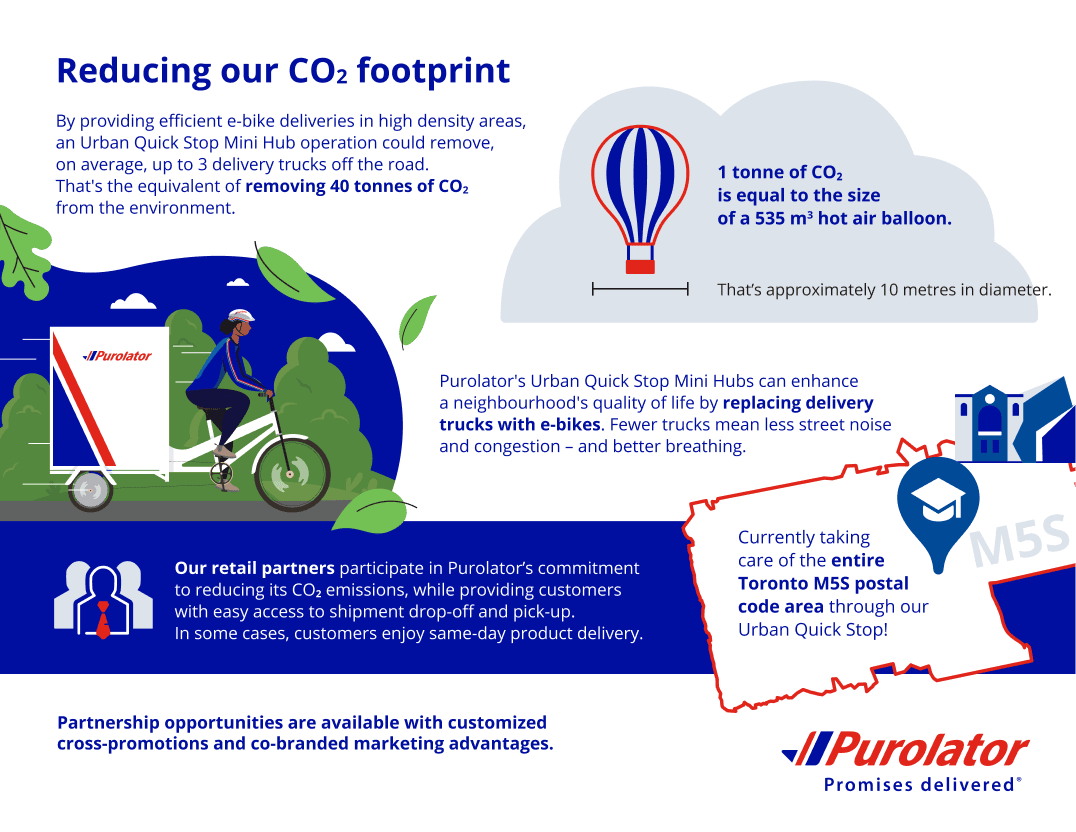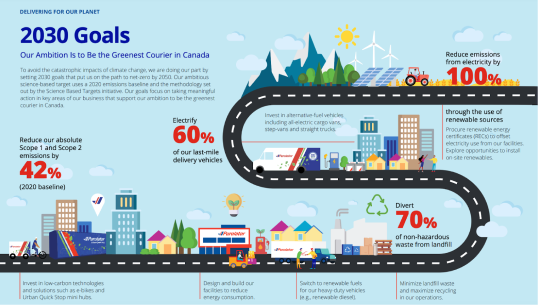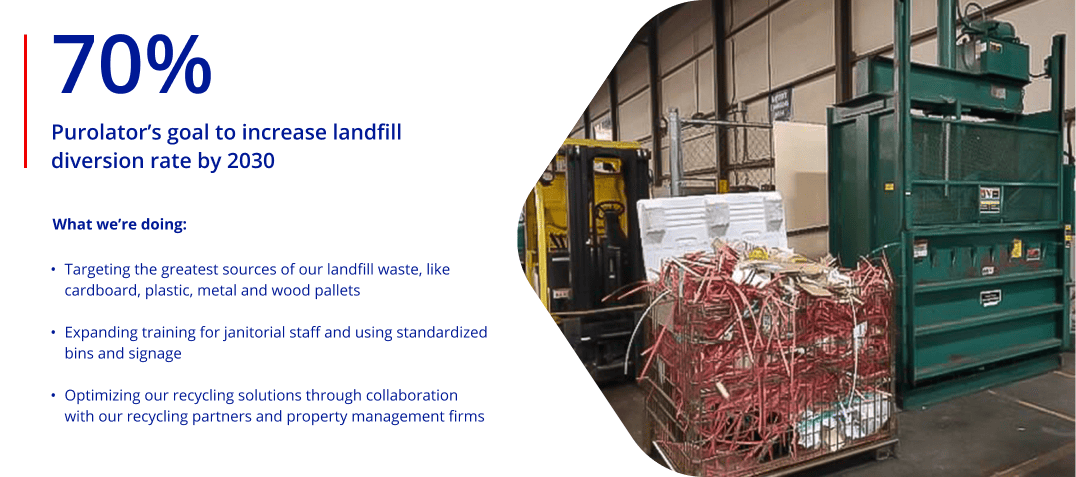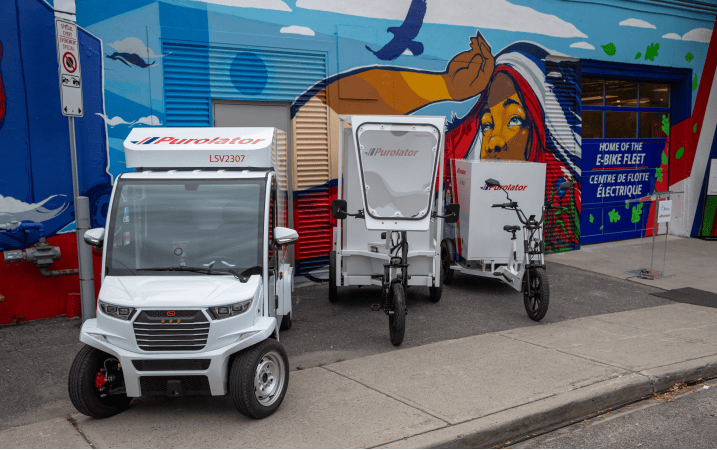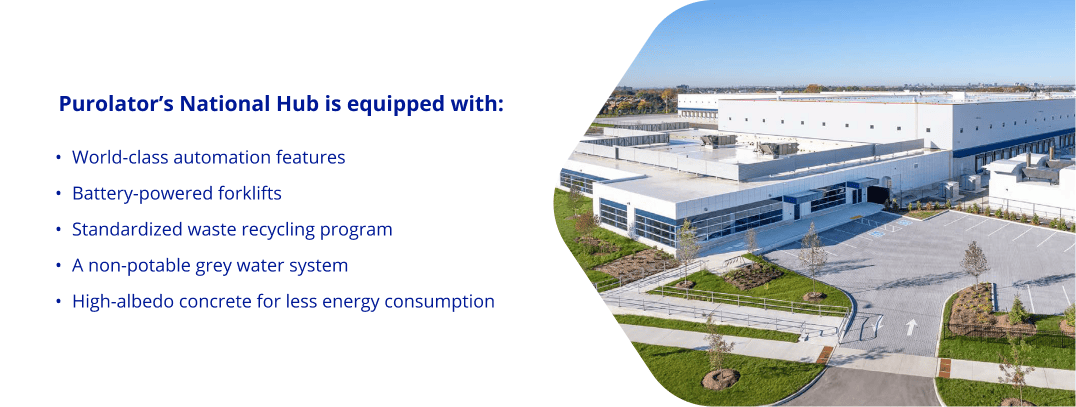Businesses big and small are tackling climate issues and striving to reduce their emissions
Setting ambitious goals to reduce your emissions is a little like setting a 2024 New Year’s resolution: it’s easier said than done. Although 60% of small and mid-sized businesses (SMBs) have plans to reduce their carbon emissions, two-thirds of owners don’t believe they have the right skills and knowledge to tackle the climate crisis. But considering over 5,200 businesses have pledged to meet net-zero carbon targets by 2050, it’s a topic any business owner should be familiar with.
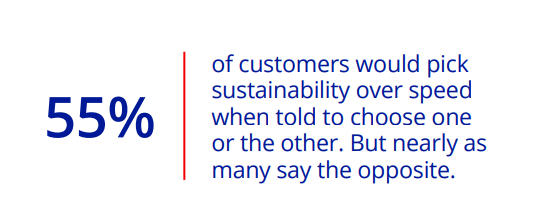 Embracing ambitious climate goals not only reduces carbon emissions, but also attracts customers who share the same values. While it may seem like a high upfront investment to adapt your value chain to low-carbon practices, the data shows that customers take notice. Our research on sustainable shipping revealed the importance that customers place on purchasing from a company that implements sustainable practices. Did you know that 40.5% of customers would pay more for sustainable delivery options?
Embracing ambitious climate goals not only reduces carbon emissions, but also attracts customers who share the same values. While it may seem like a high upfront investment to adapt your value chain to low-carbon practices, the data shows that customers take notice. Our research on sustainable shipping revealed the importance that customers place on purchasing from a company that implements sustainable practices. Did you know that 40.5% of customers would pay more for sustainable delivery options?
Article Contents
- What does net-zero mean?
- Carbon neutral vs net-zero—what’s the difference?
- Benefits of reducing your carbon emissions
- 12 strategies SMBs can implement to achieve carbon neutrality
- Understanding your emissions
- Setting ambitious goals
- Gaining board-level buy-in
- Increasing energy efficiency
- Opting for eco-friendly packaging
- Exploring zero-emission and low-carbon shipping options
- Choosing sustainable suppliers
- Engaging employees
- Educating and collaborating
- Continuously improving
- Choosing ground shipping
- Consolidating orders
- A bold green path forward
What does net-zero mean?
First, let’s define what net-zero really means. Simply put, it refers to removing the equivalent amount of greenhouse gas emissions to what’s emitted through business activities. The goal is restoring balance by ensuring the amount greenhouse gases are added to the atmosphere annually does not exceed the amount being removed. This calls for a collective effort to transition towards “true zero emissions,” a relatively newer term that means stopping emissions from being produced before they enter the atmosphere. For businesses, that means moving away from burning coal, oil and natural gas and shifting to renewables.
Carbon neutral vs net-zero–what’s the difference?
It is important for companies to go beyond carbon neutrality and strive for net-zero emissions. Although carbon neutrality and net-zero are sometimes used interchangeably, they have distinct meanings. Net-zero refers to the amount of greenhouse gases (GHGs) – such as carbon dioxide (CO2), methane or sulphur dioxide – that are removed from the atmosphere being equal to those emitted by their business activities, whereas being carbon neutral just focuses on reducing carbon emissions.
The benefits of reducing your carbon emissions
Some of the key benefits of reducing your carbon emissions include:
- Demonstrated commitment to environmental sustainability, which is increasingly important to investors, funders, employees and customers.
- Realized cost savings through business activities such as waste reduction measures, energy efficiency improvements and minimized business travel expenses.
- Alignment with global climate actions that promote Scope 1, 2 and 3 emissions reductions.
- Enhanced brand and reputation as a business committed to environmental sustainability.
- Improved public relations, which builds trust with stakeholders and attracts investments from environmentally conscious investors.
12 strategies SMBs businesses can implement to achieve carbon neutrality
Here are 12 real-world examples from Purolator and other businesses who are tackling the climate crisis. Let’s dive in.
Understand your emissions
Understanding your business’s emissions profile is the first step towards setting goals and reducing your emissions. This includes calculating your carbon dioxide equivalent (CO2e) footprint by adding up the emissions your organization creates. Reporting on your carbon emissions allows you to identify areas to prioritize reductions for the greatest impact on reducing your business’ carbon footprint.
Learn how to reduce your carbon footprint. Get expert tips about working with the right shipping partner. Learn more
When calculating baseline emissions, it’s important to differentiate between Scope 1, 2 and 3 emissions categories. This is a way to account for different kinds of carbon emissions a company creates in its own operations, and in its wider value chain.
How Purolator calculates its Scope 1, 2 and 3 emissions
We measure our Scope 1, 2 and 3 GHG emissions associated with our business through a comprehensive annual GHG emissions inventory prepared according to the ISO 14064-1 standard and the World Resources Institute (WRI) Greenhouse Gas Protocol.
In 2022, we expanded our inventory to include additional Scope 3 emission categories, including purchased goods and services and capital goods. We once again completed third-party verification of our GHG emissions inventory and restated and reverified our GHG emission inventories for both 2020 and 2021.
We continuously seek ways to reduce our emissions by investing in alternative fuel vehicles, procuring renewable electricity and improving the energy efficiency of our facilities. We also encourage GHG emissions reductions throughout our value chain and offer carbon reporting services to our customers.
See a full breakdown of Purolator’s Scope 1, 2 and 3 emissions in Purolator’s 2022 Sustainability Report. Download the report
Set ambitious goals
Once you’ve gained a clear understanding of your major sources of emissions, you’re ready to establish realistic and measurable reduction goals. Look at your carbon data and identify which parts of your business are producing the most carbon and set ambitious reduction goals.
These goals should align with international standards and frameworks. In 2022, Purolator signed a commitment letter with the Science-Based Targets initiative (SBTi) to establish 2030 science-based emissions reduction goals, joining over 2,400 companies who have made the same pledge.
Let’s look at Purolator’s 2030 goals:
- Reduce our absolute Scope 1 and Scope 2 emissions by 42%.
- Electrify 60% of our last-mile delivery vehicles.
- Reduce emissions from electricity by 100% through the use of renewable sources.
- Divert 70% of non-hazardous waste from landfills.
After setting your goals, you’re ready to start collaborating internally to find ways to achieve your goals and take action.
Gain board-level buy-in
So you’ve set your goals. Now what? To achieve these goals, businesses can implement various strategies like energy-efficient technologies, optimized transportation and logistics, renewable energy sources, waste reduction and recycling programs and engaging with suppliers to encourage sustainability practices.
But before you go any deeper in putting these strategies into action, it’s important to gain buy-in from leadership. This is a key step to ensure the success of your decarbonization efforts, because when it comes time to make trade-offs, you’ll need leadership’s support to protect your time, priorities and resources.
Atlassian, an Australian software company, wanted to make sure their leadership team bought into the business case for a sustainability program. They presented their vision and the results from their materiality assessment to their executive team and partners and solicited feedback in the hopes of building alignment. During these conversations, Atlassian was able to come to an understanding of what each team could contribute and what the program and goals could look like. For a detailed look at their process and key learnings to get leadership on board, check out their resource, Don’t #@!% the Planet.
Gaining buy-in with IKEA’s leadership team to achieve 100% zero emissions for home deliveries and becoming climate-positive proved to be an easy task, in large part due to the fact that the goal was set at the global level. Not only is the goal clearly communicated to employees at every level, but sustainability is also one of IKEA’s core values. These overarching company commitments make it much easier for effective sustainability programs and initiatives to be successful.
Increase energy efficiency
Making the switch to renewable energy sources is one of the most effective strategies for businesses to decarbonize and reduce their environmental impact. There are several practical approaches to achieve this:
- Retrofit for energy efficiency by swapping fluorescent or incandescent light bulbs with LEDs, which are 90% more energy efficient. Change overhead lighting, desk lamps and any other lighting in the workplace.
- Purchase renewable energy through electricity supply contracts sourced from renewable providers, which ensures that the power consumed is from sustainable sources. Many energy providers like Bullfrog Power offer renewable energy plan options for homes and businesses.
- Invest in renewable energy sources and consider installing solar panels at your business or a ground heating system and geothermal heat pump. The government often offers tax credits and financial incentives for new renewable installations.
- Invest in battery storage systems. Store the excess energy generated from your renewable energy sources like solar panels or wind and use it during peak demand periods to lower your energy costs and reliance on the grid.
By implementing these initiatives, businesses can not only reduce their carbon footprint but also benefit from energy cost savings, energy independence and a positive brand reputation associated with sustainability efforts. According to our sustainability research report on customer expectations, customers—especially millennials and Gen Z audience segments—value companies that are making efforts towards sustainability. See comment about image above.
Opt for sustainable packaging
Eco-friendly packaging is another way to shrink your carbon footprint. Depending on your packaging and shipping materials, you can not only reduce greenhouse gas emissions, but also decrease waste to landfills, conserve natural resources and attract eco-conscious consumers. How’s that for a win-win? Here are some eco-friendly packaging solutions to consider:
- Choose recycled materials. From boxes to containers, choose recycled or recyclable materials to reduce your carbon footprint. Corrugated boxes, recycled fillers and eco-friendly mailers are just a few examples of how to integrate recycled materials into your processes.
- Use the “right-sized packaging”. Using an array of box sizes allows you to fit your products in smaller packages. Some companies like IKEA have gone a step further and designed their packaging with the goal to minimize the amount of air around their products, use fewer materials and fit boxes optimally on shipping pallets.
- Offer package free returns. Some shipping providers offer packageless returns, which allows customers to bring in their items without a box or package. In 2021, Purolator initiated a package-free returns program for Amazon shipments, which allowed customers to return products without shipping packaging to our drop-off locations. Making returns easier is a great way to encourage a circular economy where we produce less virgin material and reuse and recycle more.
Purolator’s commitment to reducing landfill waste aligns perfectly with our dedication to finding sustainable package solutions. We understand that sustainable packaging solutions, such as using recyclable or biodegradable materials, can significantly contribute to reducing landfill waste.
We’ve already implemented comprehensive recycling programs in our top landfill waste generating facilities, and we’re not stopping there. Our goal is to increase that diversion rate to more than 70% by 2030. To do this, we’re targeting the greatest sources of our landfill waste—like cardboard, plastic, metal and wood pallets. We’re also expanding training for janitorial staff and using standardized bins and signage, while optimizing our recycling solutions through collaboration with Purolator’s recycling partners and property management firms.
Explore zero-emission and low-carbon shipping options
Transportation is one of the world’s biggest sources of GHG emissions, making it an important focus for reducing a company’s carbon footprint. The answer? Zero-emission or low-carbon shipping. It’s the practice of transporting goods with the goal of bringing your net carbon output as close to zero as possible. There are different ways to achieve this with the help of your shipping provider.
-
- Optimize routes. Ensure that goods are delivered by traveling the shortest distance possible. This not only reduces fuel consumption but also minimizes carbon emissions.
- Consolidate your shipments. If you’re shipping individual products to the same address, look for opportunities to consolidate and combine multiple items into a single shipment. Reducing the number of trips can lower your carbon footprint.
- Leverage parcel lockers: Conveniently placed shipping access points can reduce the distance to deliver or pick up a package. In fact, one parcel locker can reduce as much as 13,845 kg of CO2 per year.
- Use zero-emission deliveries. This can be achieved by partnering with couriers like Purolator who offer delivery options using foot, all-electric vehicles and e-bikes.
For example, Purolator operates Urban Quick Stops, which serve as a mini hub for couriers on electric cargo bikes to retrieve and deliver packages to the surrounding areas, Purolator’s Urban Quick Stop mini hubs operation can remove, on average, up to three delivery trucks off the road. That’s the equivalent of removing 40 tonnes of C02 from the environment.
Choose sustainable suppliers
To achieve your emissions reduction goals, businesses must assess their network of suppliers and other businesses along their value chain. This includes working with suppliers who prioritize eco-friendly manufacturing processes and sourcing materials from sustainable suppliers.
Collaboration with partners who share the same values and environmental commitments is essential to create a comprehensive and sustainable supply chain. By evaluating and optimizing every step of the supply chain, businesses can make significant strides towards achieving their sustainable shipping goals.Partnering with sustainable suppliers is a key component of Purolator’s commitment to environmental responsibility, as demonstrated by our National Hub, which operates with a focus on sustainability and efficiency.
Get our sustainable logistics and supply chain management checklist. View checklist
Engage employees
By fostering a culture of sustainability within the organization, businesses can ensure that every employee is committed to working towards their shared environmental goals. Businesses must explore and implement eco-friendly workplace policies and practices within their organization, like comprehensive training programs for employees to raise awareness about sustainable practices. For example, Purolator holds internal Earth Month events, webinars and even launched a Green Team to promote eco-friendly initiatives at work.
Here are some additional approaches you can take to make your office more sustainable:
- Invite experts from academia, industry or the sustainability sector to enhance your organization’s understanding of sustainability and emissions reduction.
- Implement semi-annual town hall meetings focused on sustainable practices.
- Establish cross-functional sustainability committees.
- Create bi-weekly newsletters that highlight green initiatives across your organization.
- Encourage carpooling among employees.
- Promote the use of reusable mugs and glasses in the office.
- Implement a waste diversion program at the office.
These initiatives can help foster a culture of sustainability and contribute to reducing environmental impact in your office.
Educate and collaborate
Collaboration with other groups is an underrated, yet highly effective way to find innovative solutions to reduce your carbon footprint. Partnering with industry associations, sustainability organizations or local communities to share best practices, exchange knowledge and learn from others who are already implementing sustainable initiatives can help you accelerate your own sustainability efforts.
For example, Purolator partners with and supports environmental organizations such as Earth Day Canada, Nature Conservancy Canada, the Great Canadian Shoreline Cleanup and Waste Reduction Week.
In 2021, Purolator became involved in the North American Council for Freight Efficiency (NACFE) and RMI’s Run on Less – Electric (RoL-E) campaign. In 2023, we continued our participation in this biennial program. The 2023 event, called Run on Less – Electric DEPOT (RoL-E DEPOT), focused on scaling the deployment of electric trucks. Many fleets have deployed one or two electric trucks, but few have made the move to 15 or more. The 2023 event featured fleet depots with 15+ Class 3 to 8 battery electric vehicles (BEVs) operating in the U.S., Canada or Mexico.
Purolator is also a founding member of the Urban Delivery Solutions Initiative (UDSI). The UDSI is a first-of-its-kind coalition of businesses, clean energy providers, fleet operators and policy experts that together are tackling the growing problem of urban freight emissions.
Continuous improvement
Keeping your environmental commitments is hard work and takes continual and consistent effort. To successfully meet your goals, you should regularly re-evaluate your strategies and adapt as needed.
- Commit to annual sustainability reporting. This allows you to track your progress, identify areas for improvement and provides greater transparency to customers, partners and investors.
- Gather your leadership team regularly. By bringing executive leadership together with the sustainability team to review priorities and progress, you can ensure ongoing collaboration and keep sustainability a top priority.
Choose ground shipping
When ground shipping is a viable option, you have the ability to choose the greener last mile, as it typically decreases the shipping distance, minimizes high carbon footprint air transport and is often a more affordable solution.
By partnering with carriers like Purolator that specialize in ground transport, you can pick up and drop off packages at Mobile Quick Stops, Quick Stop Kiosks, parcel lockers and drop boxes from over 2,500 access points. We also deploy fully electric delivery trucks and ebikes, which help reduce GHG emissions by 24 metric tons per year (per vehicle).
Consolidate orders
By reducing individual shipments and consolidating orders, you can greatly reduce the carbon footprint and environmental impact of your transport. Consider choosing specific days of the week to ship groups of similar items, offering incentives to customers who are open to the idea of waiting to receive their items together and opting for less-than-truckload (LTL) shipping, which consolidates cargo from many different shippers that are moving goods in a similar direction. Not only does this allow shippers to pay only for the portion of the LTL truckload they use, but by sharing the trucks with other shippers, less emissions are put out into the environment.
Learn how your business can adopt sustainable supply chain solutions
Tackling climate change will require bold action from small and medium-sized businesses looking to decarbonize their operations and build a better future for the planet. By setting ambitious carbon-reduction goals and integrating sustainable practices into your value chain—such as transitioning to renewable energy, consolidating shipments, adopting eco-friendly packaging and leveraging zero- or low-emission shipping options—you’ll be joining thousands of businesses that are committing to protecting the planet.
Our shipping experts will help you find custom sustainable supply chain solutions—from optimizing shipping routes, to sustainable packaging to low-carbon shipping options.
